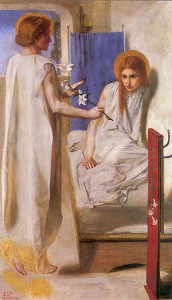The Annunciation – Celebrating Incarnation and a Young Woman’s “Yes” to God
March 25 is the feast of the Annunciation, the celebration of the visit by the angel Gabriel to a young woman in Nazareth to ask a great favor of her. The Lord of Hosts, Creator of all that is, was and ever will be, requested her consent to becoming the Mother of God (Theotokos or God-bearer), Mother of the Incarnate Word of God, Mother of His Son. The story of this visit is recounted in Christian scriptures (Lk 1:26-38, Mt 1:18-21) and also in the Qu’ran (Sura 3: 45-51).
With Mary’s courageous decision to consent to the Lord’s request, a new era in the history of human relations with the Lord opened. In a time and place where women were little valued or respected and had fewer rights than men, the consent of a woman who was little beyond childhood and was still unmarried was solicited and respected by the greatest power of all – her creator and ours.
This feast has been celebrated since the earliest days of the Christian community, probably even predating the celebration of Christmas. Celebration of the Annunciation (and therefore of the Incarnation) coincides with the general time frame of the celebration of the Passover and Exodus, events that formed the Jewish community into a nation, beginning their history as a people. With the Annunciation and the Incarnation, the life of a new community began and the history of salvation took a new turn that eventually led to inclusion of all peoples on Earth.
Selection of the date for the celebration was not random. It coincided with the timing of the birth of John the Baptist, conceived following the time of his father’s service within the Holy of Holies on the Feast of Atonement in the fall. The Annunciation took place six months later, putting it in early spring. Based on those dates, John the Baptist’s birth was celebrated in June and Jesus’ birth date came to be set as December 25.
Setting the date of the Annunciation in spring also followed the Jewish tradition of celebrating beginnings and endings on or around the same date. It was known that Jesus’ death and resurrection occurred at Passover time. Setting the beginning of his life, his conception, at the same general time made sense to the early community. The big innovation was that for Christians, his conception marked the beginning of life, rather than his actual physical birth. (The “womb to tomb” tradition thus has ancient roots as well.)
Moving forward a few hundred years, in 525 when the new calendar was introduced by Dionysius Exiguus, the Anno Domini calendar, March 25 was set as the first day of the year. The Christian community considered it to be the beginning of a new era of grace.
May we, as we continue to live out our lives as sharers in the mystery of incarnation, rejoice with the angels and saints, and with Our Lord as well, the great blessing of a young woman’s willingness to trust that her Lord would never ask too much of her.
Let us join with our sisters and brothers in the Eastern Christian churches in rejoicing on this day.
-
- Today is the beginning of our salvation,
- And the revelation of the eternal mystery!
- The Son of God becomes the Son of the Virgin
- As Gabriel announces the coming of Grace.
- Together with him let us cry to the Theotokos:
- “Rejoice, O Full of Grace, the Lord is with you!”










